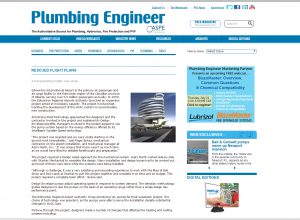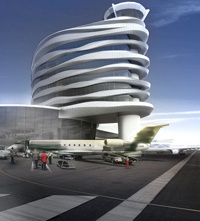 As seen on plumbingengineer.com– May 2016
As seen on plumbingengineer.com– May 2016
A transportation facility case study.
Edmonton International Airport is the primary air passenger and air cargo facility in the Edmonton region of the Canadian province of Alberta, serving over 6.6 million passengers annually. In 2009, the Edmonton Regional Airports Authority launched an expansion project aimed at increasing capacity. The project involved fast-tracking the development of the HVAC system to accommodate new construction.
 Armstrong Fluid Technology approached the designers and the contractor involved in the project and explained its Design Envelope benefits. Managers involved in the project agreed to use the pump system based on the energy efficiency offered by its Intelligent Variable Speed technology.
Armstrong Fluid Technology approached the designers and the contractor involved in the project and explained its Design Envelope benefits. Managers involved in the project agreed to use the pump system based on the energy efficiency offered by its Intelligent Variable Speed technology.
“The project was awarded and we were onsite starting on the ground work immediately,” said Roger Buksa, mechanical contractor on the airport installation, and mechanical manager at Arpi’s North, Inc. “It was unique that there wasn’t as much time as we would have liked for detailed forethought and preparation.”
The project required a Design Assist approach for the mechanical system. Arpi’s North worked side-by-side with Stantec Mechanical to complete the design. Many installation and design issues had to be worked out, and most of them were done while the systems were being installed.
“Although a challenge, it was a very satisfying and rewarding experience to work with the likes of Bob Shaw and Paul Lamb at Stantec to pull this project together and complete it on time and on budget. This project required a complete team effort,” Buksa said.
Design Envelope pumps adjust operating speed in response to system demand. The selection methodology guides designers to size the pumps on the basis of an operating range rather than a single design day performance point.
The Edmonton Regional Airport Authority chose Armstrong VIL pumps for their expansion project. The choice of technology was prescient, as the pumps were able to serve the installation despite substantial changes in HVAC load.
Partway through the project, designers made a number of changes that affected the heating and cooling systems including:
- Revisions to the original piping design resulting in load changes to several zones
- Reduction in project scope, leaving out one major section of the expansion
- Changing air handlers from constant speed to variable speed
Security issues were a constant concern throughout the project because the facility was an airport. Though it was not a significant issue for work on the main portion of the building, any interconnection between the airport property and the new building was a challenge.
“If you went through a secure door, even if you had the key but had the wrong clearance on your security card, you could find yourself under arrest and in questioning,” Buksa noted. “This didn’t happen often, but many workers had to traverse between several areas that went in and out of secure areas. Sometimes you were in the wrong place with the wrong credentials.”
The size of the project was also a challenge. Designers and contractors onsite had over half of a mile to walk from the bottom floor project entry point, up to the top level for work, and back to the entrance.
“The building is no more than 150 feet wide, but it is very long. It was a logistical challenge to get material and equipment to the areas required while dealing with limited movement in the full construction non-active airport areas, known as green spaces, and the active airport areas,” Buksa explained.
Arpi’s North dealt with two portions of the airport expansion — the new addition and renovation to the connection point between the old and new buildings. There were four major parts to the expansion in addition to a new tower.
“The short schedule, organizing the work, completing connections between the new and existing building, and any work being completed in the existing building were all challenges,” Buksa said. “It’s hard enough to complete your work on a tight schedule. But, when you add in limited work access due to security and work stoppages due to incoming flights, things start to get interesting.”
In the process of preparing the original HVAC plans, estimates for required head and flow were generated using a formula involving square footage.
Reviewing the updated building plans, the designers realized that the system flow and head requirements were substantially lower. It appeared that project managers might need to revise their order, even though the pumps had been completed and shipped to site. However, because the Design Envelope technology provides high-quality efficiency across a range of operation, contractors were able to turn down the operating speed of the pumps, rather than replace them with new units.
The net result of the design changes and the inaccurate flow and head estimates was that the pumps, as originally selected, were oversized. Because of the flexibility of the new pumps, the actual duty points were within the performance envelope of the originally selected pumps.
In all, only 12 of the original 90 pumps had to be changed for smaller units. The other pumps automatically adjusted to the required head and flow, using the Intelligent Variable Speed capability that constantly adjusts pumping performance to match flow requirements.
The system designers and contractors on the project were understandably delighted that the originally purchased equipment would serve the building efficiently, even though there was a mismatch in sizing. The engineering firm saved approximately $12,000 on design-related time because there was no requirement to revisit the pump selections.
The Prime Mechanical Contractor had to manage 4-6 subcontractors. Having the entire mechanical team on the same page and working together was critical.
“I would be remiss not to mention the efforts of all the contractors on the project. Everyone had one goal in mind when the project started and that was to make the completion date. From the beginning, all the contractors collaborated to bring this project to a successful conclusion,” Buksa noted. “Thanks to the efforts of the Prime Mechanical Contractor, there was solid teamwork and the contractors were in line and focused on the objective.”
After the project, the Edmonton Regional Airports Authority still had available land that, should they require added facilities, the pumping capacity to serve expanded heating and cooling systems is already in place.



